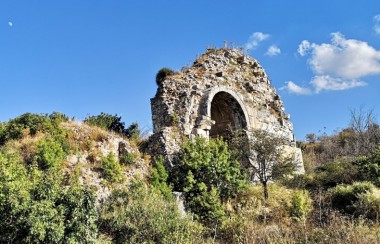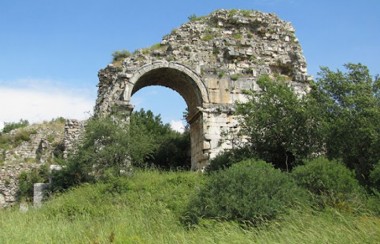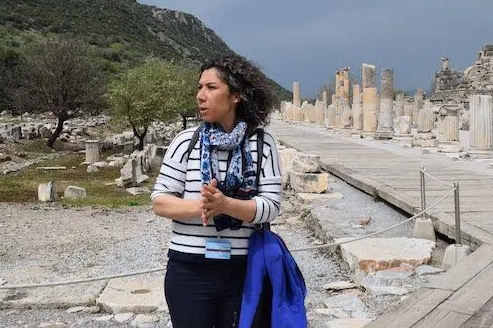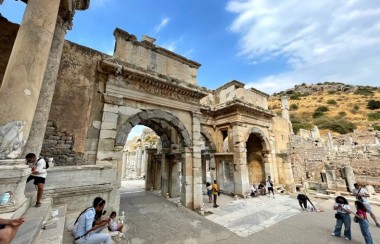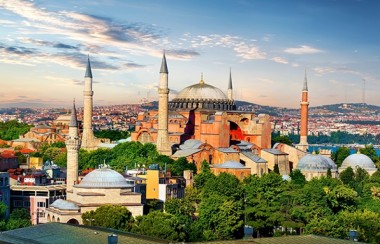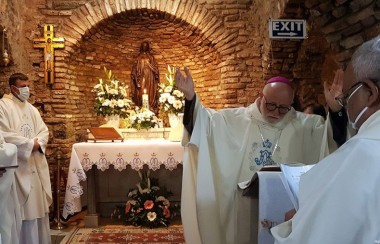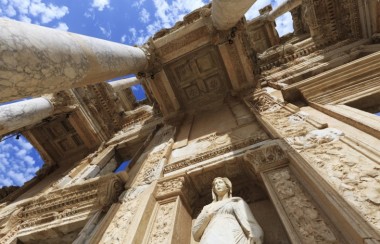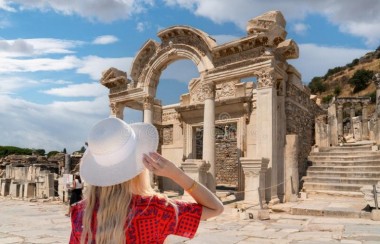The stadium of Ephesus is located just to the south of the Vedius Gymnasium, in a depression near the Pion Hill. This was the place where celebrations of all kinds were held, including sports events, chariot races, and gladiatorial combats. Most probably, the first stadium in this location was erected in the Hellenistic times by king Lysimachus in 3rd century BCE. To create the stadium, an artificial cavity was dug into the ground, covering the area of 3.3 hectares. The surviving traces, the dimensions, and the elongated form of the structure allowed its early identification as a stadium, oriented along the east-west axis. This Hellenistic structure was rather simple with just a flat running track and earthen banks where the spectators could sit, situated at the southern side. It was then used for religious ceremonies and sports activities.
The stadium was subsequently enlarged and rebuilt during the reign of Emperor Nero (54-68 CE) as testified by the discovered inscription. According to this inscription, engraved on the southern retaining wall of the stadium, the refurbishment was funded by a wealthy citizen named C. Stertinius Orpex, his wife Stertinia Marena, and their daughter. The works also covered the construction of vaulted substructures for the marble seats at the north side.
The sphendone, i.e. the U-shaped end of the stadium, was located at the eastern section of the structure. It measured 50 by 42 meters and in the Late Roman period this section was separated from the rest of the stadium as it was used for staging gladiatorial and wild beast fights. Local guides eagerly tell dreadful stories about the Christians that were martyred there in the early years of Christianity.
It is possible that the first gladiatorial games in Asia Minor took place in the stadium of Ephesus. They were organised by Lucius Licinius Lucullus who arrived in Asia Minor to participate in the Third Mithridatic War. Plutarch described his stay in Ephesus in the biography of Lucullus in the famous series of Parallel Lives: "Lucullus, after filling Asia full of law and order, and full of peace, did not neglect the things which minister to pleasure and win favour, but during his stay at Ephesus gratified the cities with processions and triumphal festivals and contests of athletes and gladiators. And the cities, in response, celebrated festivals which they called Lucullea, to do honour to the man, and bestowed upon him what is sweeter than honour, their genuine good-will."
The stadium was a U-shaped building measuring 229 by 28 meters. The seats for spectators on the southern side were built into the slope of Pion Hill (now Panayırdağ). Spectators entered the northern side of the stadium through two outer staircases and a vaulted internal corridor, 85 meters long. In the south-western section of the stadium, there was a monumental gate, still preserved in good condition. Archaeological research has discovered water pipes running through the southern section of the stadium. Quite possibly, they supplied water for mock-naval battles, fashionable during the Roman period.
The earthquake of 262 CE severely damaged the stadium. The north façade was never repaired, but the south-western gate and parts of the west side were rebuilt. The conversion of the sphendone into an arena for gladiatorial fights should be dated to this period. A further series of earthquakes in the mid-4th century further damaged the building. Interestingly, in the 5th century CE, a church was erected over the stadium as testified by the excavations carried out in 1994. They revealed parts of a peristyle, which was recognised as the atrium of a church, incorporated into the western end of the northern vaults. This church was used until the Seljuk conquest of the city at the end of the 11th century. However, from the 5th century onwards, the track of the stadium fell into disuse and was used as farming land. Moreover, a necropolis began surrounding the wider area of the church.
Currently, little is preserved from the stadium, because the stone seats were dismantled and used to build ramparts and the Basilica of St. John on Ayasuluk Hill in early Christian times. Only the western part of the stadium has been excavated by archaeologists so far. During the excavations, marble vases that served as sports trophies were found, as well as plates decorated with designs depicting olive branches and rabbits, dating back to the 3rd and the 4th centuries CE.
Related Shore Excursions
Explore Ephesus History with our Shore Excursions .
Ancient City Of Ephesus Exclusive
Majestic Ephesus takes you on an unforgettable journey through history; etched on minds as the...
Roman Heritage & Ottoman Marvels
Blue Mosque, Byzantine Hippodrome, Hagia Sophia, Mevlana Bazaar, Topkapi Palace
Highlights Of Ephesus Half Day
Majestic Ephesus takes you on an unforgettable journey through history; etched on minds as the...
Ultimate Ephesus
Terrace Houses: Admire the frescoed walls, mosaic flooring and peristyle courtyards of homes where E...
Discover Majestic Ephesus
Majestic Ephesus takes you on an unforgettable journey through history; etched on minds as the...

